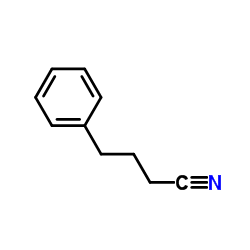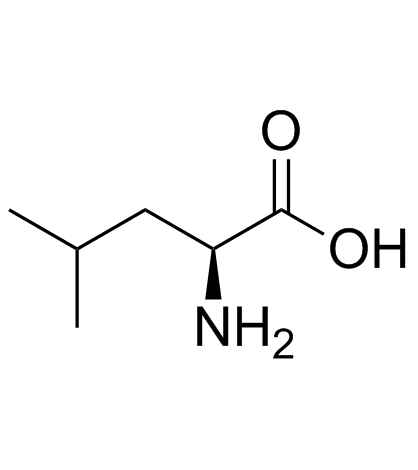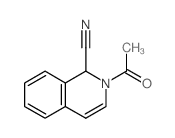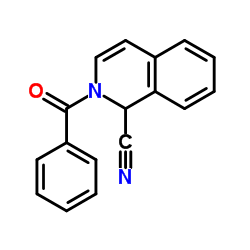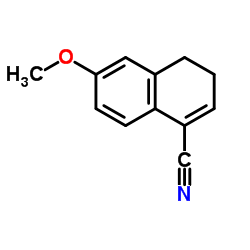5804-85-3
| 中文名 | 二乙基氰化铝 |
|---|---|
| 英文名 | (Cyano-κC)(diethyl)aluminium |
| 中文别名 | 氰化二乙基铝 |
| 英文别名 |
diethylaluminiumbromide
Diaethyl-aluminium(1+),Bromid bromo-diethylalumane diethyl aluminum bromide Aluminum,bromodiethyl diethyl aluminium cyanide MFCD00001764 diethyl aluminium (1+),bromide Bromodiethylaluminium diethylaluminum cyanide BROMODIETHYLALUMINUM Nagata's reagent |
| 分子式 | C5H13AlN |
|---|---|
| 分子量 | 114.14500 |
| 精确质量 | 114.08600 |
| PSA | 23.79000 |
| LogP | 2.03508 |
| 储存条件 | 密闭保存,阴凉处避光 |
| 稳定性 | 1.避免强氧化剂,强酸. 2.长时间贮存于安瓶中是稳定的,在四氢吠喃中不稳定。 |
| 计算化学 | 1、 疏水参数计算参考值(XlogP): 2、 氢键供体数量:0 3、 氢键受体数量:1 4、 可旋转化学键数量:2 5、 互变异构体数量: 6、 拓扑分子极性表面积(TPSA):23.8 7、 重原子数量:7 8、 表面电荷:0 9、 复杂度:77.3 10、同位素原子数量:0 11、确定原子立构中心数量:0 12、不确定原子立构中心数量:0 13、确定化学键立构中心数量:0 14、不确定化学键立构中心数量:0 15、共价键单元数量:1 |
| 更多 | 1. 性状:淡黄色粘稠油状物 2. 密度(g/mLat 25°C):0.864 3. 相对蒸汽密度(g/mL,空气=1):未确定 4. 熔点(ºC):未确定 5. 沸点(ºC,常压):未确定 6. 沸点(ºC,18mmHg):150 7. 折射率(n20/D):未确定 8. 闪点(ºC):7 9. 比旋光度(º):未确定 10. 自燃点或引燃温度(ºC):未确定 11. 蒸气压(mmHg,37ºC):未确定 12. 饱和蒸气压(kPa,114.4 ºC):未确定 13. 燃烧热(KJ/mol):未确定 14. 临界温度(ºC):未确定 15. 临界压力(MPa):未确定 16. 油水(辛醇/水)分配系数的对数值:未确定 17. 爆炸上限(%,V/V):未确定 18. 爆炸下限(%,V/V):未确定 19. 溶解性:溶于苯、甲苯、已烷或异丙醚. |
|
SECTION 1: Identification of the substance/mixture and of the company/undertaking Product identifiers Product name: Diethylaluminum cyanide solution REACH No.: A registration number is not available for this substance as the substance or its uses are exempted from registration, the annual tonnage does not require a registration or the registration is envisaged for a later registration deadline.
Relevant identified uses of the substance or mixture and uses advised against Identified uses: Laboratory chemicals, Manufacture of substances SECTION 2: Hazards identification Classification of the substance or mixture Classification according to Regulation (EC) No 1272/2008 Flammable liquids (Category 2), H225 Acute toxicity, Oral (Category 2), H300 Acute toxicity, Inhalation (Category 1), H330 Acute toxicity, Dermal (Category 3), H311 Skin irritation (Category 2), H315 Reproductive toxicity (Category 2), H361d Specific target organ toxicity - single exposure (Category 3), H336 Specific target organ toxicity - repeated exposure (Category 2), H373 Aspiration hazard (Category 1), H304 Acute aquatic toxicity (Category 1), H400 For the full text of the H-Statements mentioned in this Section, see Section 16. Classification according to EU Directives 67/548/EEC or 1999/45/EC F Highly flammableR11 T+ Very toxicR26/27/28 Xn HarmfulR65, R48/20 Xn HarmfulR63 Xi IrritantR38 N Dangerous for theR50/53 environment R32 For the full text of the R-phrases mentioned in this Section, see Section 16. Label elements Labelling according Regulation (EC) No 1272/2008 Pictogram Signal wordDanger Hazard statement(s) H225Highly flammable liquid and vapour. H300Fatal if swallowed. H304May be fatal if swallowed and enters airways. H311Toxic in contact with skin. H315Causes skin irritation. H330Fatal if inhaled. H336May cause drowsiness or dizziness. H361dSuspected of damaging the unborn child. H373May cause damage to organs through prolonged or repeated exposure. H400Very toxic to aquatic life. Precautionary statement(s) P210Keep away from heat/sparks/open flames/hot surfaces. - No smoking. P260Do not breathe dust/ fume/ gas/ mist/ vapours/ spray. P264Wash hands thoroughly after handling. P273Avoid release to the environment. P280Wear protective gloves/ protective clothing. P284Wear respiratory protection. Supplemental Hazard information (EU) EUH032Contact with acids liberates very toxic gas. According to European Directive 67/548/EEC as amended. Hazard symbol(s)F Highly flammable T+ Very toxic N Dangerous for the environment R-phrase(s) R11Highly flammable. R26/27/28Very toxic by inhalation, in contact with skin and if swallowed. R32Contact with acids liberates very toxic gas. R38Irritating to skin. R48/20Harmful: danger of serious damage to health by prolonged exposure through inhalation. R50/53Very toxic to aquatic organisms, may cause long-term adverse effects in the aquatic environment. R63Possible risk of harm to the unborn child. R65Harmful: may cause lung damage if swallowed. S-phrase(s) S16Keep away from sources of ignition - No smoking. S28After contact with skin, wash immediately with plenty of water. S36/37Wear suitable protective clothing and gloves. S45In case of accident or if you feel unwell, seek medical advice immediately (show the label where possible). S61Avoid release to the environment. Refer to special instructions/ Safety data sheets. S62If swallowed, do not induce vomiting: seek medical advice immediately and show this container or label. Other hazards - none SECTION 3: Composition/information on ingredients Mixtures Chemical characterization : Natural product Formula: C5H10AlN Molecular Weight: 111,12 g/mol Hazardous ingredients according to Regulation (EC) No 1272/2008 ComponentClassificationConcentration Toluene CAS-No.108-88-3Flam. Liq. 2; Skin Irrit. 2; Repr. 50 - 100 % EC-No.203-625-92; STOT SE 3; STOT RE 2; Index-No.601-021-00-3Asp. Tox. 1; H225, H304, H315, H336, H361d, H373 (Cyano-C)diethylaluminium CAS-No.5804-85-3Acute Tox. 2; Aquatic Acute 1; 10 - 20 % EC-No.227-359-8H300, H310, H330, H400, EUH032 Hazardous ingredients according to Directive 1999/45/EC ComponentClassificationConcentration Toluene CAS-No.108-88-3F, Xn, Repr.Cat.3, R11 - R38 - 50 - 100 % EC-No.203-625-9R48/20 - R63 - R65 - R67 Index-No.601-021-00-3 (Cyano-C)diethylaluminium CAS-No.5804-85-3T+, N, R26/27/28 - R32 -10 - 20 % EC-No.227-359-8R50/53 For the full text of the H-Statements and R-Phrases mentioned in this Section, see Section 16 SECTION 4: First aid measures Description of first aid measures General advice Consult a physician. Show this safety data sheet to the doctor in attendance. If inhaled If breathed in, move person into fresh air. If not breathing, give artificial respiration. Consult a physician. In case of skin contact Wash off with soap and plenty of water. Take victim immediately to hospital. Consult a physician. In case of eye contact Rinse thoroughly with plenty of water for at least 15 minutes and consult a physician. If swallowed Do NOT induce vomiting. Never give anything by mouth to an unconscious person. Rinse mouth with water. Consult a physician. Most important symptoms and effects, both acute and delayed The most important known symptoms and effects are described in the labelling (see section 2.2) and/or in section 11 Indication of any immediate medical attention and special treatment needed no data available SECTION 5: Firefighting measures Extinguishing media Suitable extinguishing media Dry powder Special hazards arising from the substance or mixture Carbon oxides, nitrogen oxides (NOx), Aluminum oxide Advice for firefighters Wear self contained breathing apparatus for fire fighting if necessary. Further information no data available SECTION 6: Accidental release measures Personal precautions, protective equipment and emergency procedures Wear respiratory protection. Avoid breathing vapours, mist or gas. Ensure adequate ventilation. Remove all sources of ignition. Evacuate personnel to safe areas. Beware of vapours accumulating to form explosive concentrations. Vapours can accumulate in low areas. For personal protection see section 8. Environmental precautions Prevent further leakage or spillage if safe to do so. Do not let product enter drains. Discharge into the environment must be avoided. Methods and materials for containment and cleaning up Contain spillage, and then collect with an electrically protected vacuum cleaner or by wet-brushing and place in container for disposal according to local regulations (see section 13). Do not flush with water. Reference to other sections For disposal see section 13. SECTION 7: Handling and storage Precautions for safe handling Avoid contact with skin and eyes. Avoid inhalation of vapour or mist. Keep away from sources of ignition - No smoking.Take measures to prevent the build up of electrostatic charge. For precautions see section 2.2. Conditions for safe storage, including any incompatibilities Store in cool place. Keep container tightly closed in a dry and well-ventilated place. Containers which are opened must be carefully resealed and kept upright to prevent leakage. Never allow product to get in contact with water during storage. Do not store near acids. Handle and store under inert gas. Handle and open container with care. Air sensitive. Specific end use(s) A part from the uses mentioned in section 1.2 no other specific uses are stipulated SECTION 8: Exposure controls/personal protection Control parameters Components with workplace control parameters Exposure controls Appropriate engineering controls Avoid contact with skin, eyes and clothing. Wash hands before breaks and immediately after handling the product. Personal protective equipment Eye/face protection Face shield and safety glasses Use equipment for eye protection tested and approved under appropriate government standards such as NIOSH (US) or EN 166(EU). Skin protection Handle with gloves. Gloves must be inspected prior to use. Use proper glove removal technique (without touching glove's outer surface) to avoid skin contact with this product. Dispose of contaminated gloves after use in accordance with applicable laws and good laboratory practices. Wash and dry hands. The selected protective gloves have to satisfy the specifications of EU Directive 89/686/EEC and the standard EN 374 derived from it. Full contact Material: Fluorinated rubber Minimum layer thickness: 0,7 mm Break through time: 480 min Material tested:Vitoject® (KCL 890 / Z677698, Size M) Splash contact Material: Fluorinated rubber Minimum layer thickness: 0,7 mm Break through time: 480 min Material tested:Vitoject® (KCL 890 / Z677698, Size M) data source: KCL GmbH, D-36124 Eichenzell, phone +49 (0)6659 87300, test method: EN374 If used in solution, or mixed with other substances, and under conditions which differ from EN 374, contact the supplier of the CE approved gloves. This recommendation is advisory only and must be evaluated by an industrial hygienist and safety officer familiar with the specific situation of anticipated use by our customers. It should not be construed as offering an approval for any specific use scenario. Body Protection Complete suit protecting against chemicals, Flame retardant antistatic protective clothing, The type of protective equipment must be selected according to the concentration and amount of the dangerous substance at the specific workplace. Respiratory protection Where risk assessment shows air-purifying respirators are appropriate use a full-face respirator with multi-purpose combination (US) or type ABEK (EN 14387) respirator cartridges as a backup to engineering controls. If the respirator is the sole means of protection, use a full-face supplied air respirator. Use respirators and components tested and approved under appropriate government standards such as NIOSH (US) or CEN (EU). Control of environmental exposure Prevent further leakage or spillage if safe to do so. Do not let product enter drains. Discharge into the environment must be avoided. SECTION 9: Physical and chemical properties Information on basic physical and chemical properties a) AppearanceForm: clear, liquid Colour: dark brown b) Odourno data available c) Odour Thresholdno data available d) pHno data available e) Melting point/freezingno data available point f) Initial boiling point andno data available boiling range g) Flash point7 °C - closed cup h) Evapouration rateno data available i) Flammability (solid, gas) no data available j) Upper/lowerno data available flammability or explosive limits k) Vapour pressureno data available l) Vapour densityno data available m) Relative density0,870 g/cm3 n) Water solubilityno data available o) Partition coefficient: n- no data available octanol/water p) Auto-ignitionno data available temperature q) Decompositionno data available temperature r) Viscosityno data available s) Explosive propertiesno data available t) Oxidizing propertiesno data available Other safety information no data available SECTION 10: Stability and reactivity Reactivity no data available Chemical stability Stable under recommended storage conditions. Possibility of hazardous reactions no data available Conditions to avoid Heat, flames and sparks. Extremes of temperature and direct sunlight. Incompatible materials Keep away from water., Strong oxidizing agents, Strong acids Hazardous decomposition products Other decomposition products - no data available In the event of fire: see section 5 SECTION 11: Toxicological information Information on toxicological effects Acute toxicity no data available Skin corrosion/irritation no data available Serious eye damage/eye irritation no data available Respiratory or skin sensitisation no data available Germ cell mutagenicity no data available Carcinogenicity IARC:3 - Group 3: Not classifiable as to its carcinogenicity to humans (Toluene) Reproductive toxicity no data available Specific target organ toxicity - single exposure no data available Specific target organ toxicity - repeated exposure no data available Aspiration hazard no data available Additional Information RTECS: Not available Inhalation studies on toluene have demonstrated the development of inflammatory and ulcerous lesions of the penis, prepuce, and scrotum in animals., Material is extremely destructive to tissue of the mucous membranes and upper respiratory tract, eyes, and skin., spasm, inflammation and edema of the larynx, spasm, inflammation and edema of the bronchi, pneumonitis, pulmonary edema, burning sensation, Cough, wheezing, laryngitis, Shortness of breath, Headache SECTION 12: Ecological information Toxicity no data available Persistence and degradability no data available Bioaccumulative potential no data available Mobility in soil no data available Results of PBT and vPvB assessment PBT/vPvB assessment not available as chemical safety assessment not required/not conducted Other adverse effects Very toxic to aquatic life. SECTION 13: Disposal considerations Waste treatment methods Product Burn in a chemical incinerator equipped with an afterburner and scrubber but exert extra care in igniting as this material is highly flammable. Offer surplus and non-recyclable solutions to a licensed disposal company. Contaminated packaging Dispose of as unused product. SECTION 14: Transport information UN number ADR/RID: 3123IMDG: 3123IATA: 3123 UN proper shipping name ADR/RID: TOXIC LIQUID, WATER-REACTIVE, N.O.S. ((Cyano-C)diethylaluminium, Toluene) IMDG: TOXIC LIQUID, WATER-REACTIVE, N.O.S. ((Cyano-C)diethylaluminium, Toluene) IATA:Toxic liquid, water-reactive, n.o.s. ((Cyano-C)diethylaluminium, Toluene) Passenger Aircraft: Not permitted for transport Transport hazard class(es) ADR/RID: 6.1 (4.3)IMDG: 6.1 (4.3)IATA: 6.1 (4.3) Packaging group ADR/RID: IIMDG: IIATA: I Environmental hazards ADR/RID: noIMDG Marine pollutant: noIATA: no Special precautions for user no data available SECTION 15 - REGULATORY INFORMATION N/A SECTION 16 - ADDITIONAL INFORMATION N/A |
| 符号 |




GHS02, GHS06, GHS08, GHS09 |
|---|---|
| 信号词 | Danger |
| 危害声明 | H225-H300 + H330-H304-H311-H315-H336-H361d-H373-H400 |
| 补充危害声明 | Contact with acids liberates very toxic gas. |
| 警示性声明 | P210-P260-P264-P273-P280-P284 |
| 个人防护装备 | Eyeshields;Faceshields;full-face respirator (US);Gloves;multi-purpose combination respirator cartridge (US);type ABEK (EN14387) respirator filter |
| 危害码 (欧洲) | F,T+,N |
| 风险声明 (欧洲) | 11-26/27/28-32-38-48/20-50/53-63-65-67 |
| 安全声明 (欧洲) | 36/37-45-60-61-62 |
| 危险品运输编码 | UN 3123 6.1/PG 1 |
| 闪点(华氏) | 44.6 °F |
| 闪点(摄氏) | 7 °C |
| 上游产品 0 | |
|---|---|
| 下游产品 10 | |






